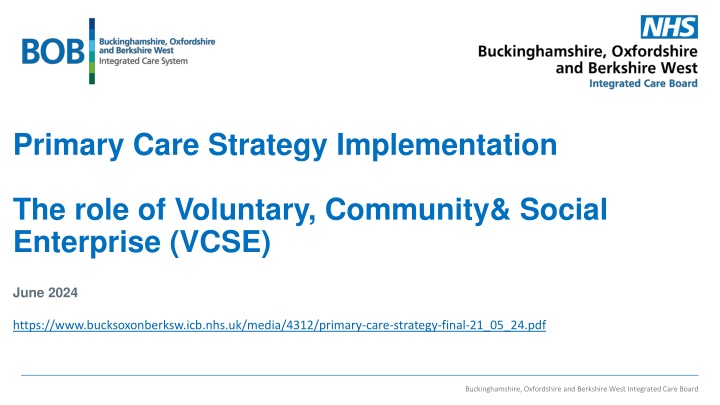The role of Voluntary, Community& Social
This document outlines the primary care strategy implementation focusing on the role of Voluntary, Community & Social Enterprise (VCSE) in June 2024. It emphasizes the importance of coordinated and integrated healthcare services to support people in staying well and receiving the right care. The strategy aims to provide personalized, proactive care for individuals with complex needs while enhancing access to information, triage services, and community-based support. Integration of multi-skilled teams, digital solutions, and effective partnerships is integral to achieving the shared vision of a transformed primary care system.
Download Presentation

Please find below an Image/Link to download the presentation.
The content on the website is provided AS IS for your information and personal use only. It may not be sold, licensed, or shared on other websites without obtaining consent from the author.If you encounter any issues during the download, it is possible that the publisher has removed the file from their server.
You are allowed to download the files provided on this website for personal or commercial use, subject to the condition that they are used lawfully. All files are the property of their respective owners.
The content on the website is provided AS IS for your information and personal use only. It may not be sold, licensed, or shared on other websites without obtaining consent from the author.
E N D
Presentation Transcript
Primary Care Strategy Implementation The role of Voluntary, Community& Social Enterprise (VCSE) June 2024 https://www.bucksoxonberksw.icb.nhs.uk/media/4312/primary-care-strategy-final-21_05_24.pdf Buckinghamshire, Oxfordshire and Berkshire West Integrated Care Board
Environment for Change Introduction Our Primary Care Our Shared Vision Approach to Delivery Appendix Our shared system vision for primary care Our Primary Care Strategy for BOB ICS has put the four pillars of Primary Care General Practice, Community Pharmacy, Optometry and Dentistry at the heart of transformation to deliver a shared ambition and vision for a new model of care and a more integrated way of working across the system. This is our future vision for primary care: Our Shared Vision Everyone in BOB has the support they need from primary care, working within a coordinated and integrated health and care system that supports people to stay well. 1 2 3 What we want to achieve Joined up, personalised, proactive care for people with multimorbidity and complex needs Support to help people stay well, prevent ill health and minimise the impact of poor health People get to the right support first time to meet their needs Improve access to information to encourage self-management Strengthen our approach to triage and directing people to the right support Ensuring people get the right support to meet their needs Embed a data driven approach to identify our most vulnerable and at-risk groups and proactively manage Introduce Integrated Neighbourhood Teams (INTs), made up of professionals from a range of disciplines, to support people with more complex needs to stay well in their communities. Actions we will take Introduce a coordinated approach to Cardiovascular Disease (CVD) prevention Estates Effective use of Public Estate and community assets to support primary care delivery. Resourcing Shift resources into community settings. Contracts focus on outcomes that deliver integrated services. Partnerships Creating effective partnerships across providers that support efficiencies and improve the patient pathway. Workforce Multi-skilled extended primary care teams working in an integrated way, at the heart of the system. Digital and data Shared patient records and connected data used for clinical decision making and to improve the patient experience Enablers for success 2
Environment for Change Introduction Our Primary Care Our Shared Vision Approach to Delivery Appendix We will provide personalised, proactive care for people with complex needs, supported by Integrated Neighbourhood Teams 2 Our vision is to have Integrated Neighbourhood Teams (INTs) made up of professionals from a range of disciplines, operating at the appropriate scale, to support people with more complex needs to stay well in their communities. Our future vision To manage the challenges on the left, we need to move towards a more community-based model. This will require the system to shift resource from secondary care into the community and will impact the way the whole system works, especially secondary care with primary care. INTs will be the delivery vehicle for this model and will involve all system providers from primary care and community care to secondary care consultants, mental health, social care providers, VCSE sector. We will need to ensure job plans are aligned and resources and time commitment are agreed upfront. The challenge today Social Prescriber Community Pharmacist Mental Health Practitioner People s health needs are changing and many live with multiple long term conditions where traditional disease- specific care is not the best model. Optometrist Occupational therapist More than one in four of the adult population live with more than two long term conditions 1 VCSE First contact physiotherapist Practice Nurse Many issues that affect people s health are not purely medical and require input from multiple parts of the public sector, for example housing, benefits. Patient supported by an Integrated Neighbourhood team who know them well and provide continuity of care GP The Buckinghamshire population have higher levels of social isolation 2 Dentist Principles of INT working will include: Keeping people well in the community for as long as possible Psychiatrist Social worker Where people s needs are not well-managed, they often end up requiring more urgent and costly treatment, that doesn t provide a positive experience or improve longer term outcomes. Groups from more deprived areas tend to end up using the emergency care system more. Care that is comprehensive and holistic Community Matron Care that is rooted in the community Paediatrician Personalised care that is shaped by the population and person's need District Nurse & Therapy Care Geriatrician Coordinator Higher acuity patients now make up a greater proportion of A&E activity than 4 years ago 3 Outcomes driven Team of colleagues from a range of contributing organisations 3 1: BOB Joint Forward Plan (2023); 2: BOB fact pack and BOB Integrated Care Strategy (2023); 3: BOB ICB ECDS Data V2 (2023)
Environment for Change Introduction Our Primary Care Our Shared Vision Approach to Delivery Appendix 2 Defining an Integrated Neighbourhood Team for BOB We recognise that INTs are not a new concept, but rather an evolution and extension of Multi-disciplinary Teams that have been operating. Each INT will look different, based on the population it is focused on and the partners involved. As a system, we have developed core principles to guide how we build INTs that will make it easier for us to explain INTs to our population and staff, and learn from each other as we develop new ways of working. Who What Supported by: INTs are the delivery vehicle for a community-based model. They will: Be a multidisciplinary team of generalist and specialist skilled health and social care professionals. Work with other partners in the neighbourhood e.g. Mental Health services and Local Housing Associations. Actively involve and engage the local community in planning and decision-making to ensure services align with population needs. Have a designated clinical lead with protected time. Have other specialist teams aligned to support and deliver services to the population cohort. Be established from existing resources and infrastructure. Integrate into service and community development in neighbourhoods, with all pillars of primary care part of the offer. Teams will develop their own standard working practices that may include: A daily or weekly huddle - where patient notes are reviewed, next steps for priority patients discussed and plans for home-visits agreed. Data is used to identify the people who could benefit the most from the service, and lists of patients are regularly reviewed together across services Any community-based care that is required for patients should be allocated to the most appropriate team e.g. district nursing. A shared care plan for people to support more coordinated care. Community teams will have regular contact with the clinical lead in the INT to ensure any complex issues are resolved and there are clear escalation paths to resolve complex cases. PHM tools to identify, understand and define a cohort to focus on High degree of trust and a culture of collaboration between health and care teams and professionals Virtual and physical space to come together Where Ability to share patient records among system partners Determine a local footprint for the INTs in each Place, guided by the service pathways and populations served. Teams do not have to be co-located in the same premises to work successfully but opportunities to engage in person, alongside virtual meetings are preferable.. 4
Environment for Change Introduction Our Primary Care Our Shared Vision Approach to Delivery Appendix 3 Example future integrated local approach to CVD prevention This slide shows an example of how all parts of the system come together at a local level to take a data-driven approach to CVD prevention, supported by system-wide shared training. Based on agreed outcome metrics, evaluate success or otherwise of intervention, share findings, and build into future planning Produce and share population risks for CVD at system, Place, Local Authority and PCN level. Do community engagement for a deeper understanding. Targeted healthy lifestyles support Monitor effectiveness of interventions Population Health Needs Analysis Voluntary and Community Groups General Practice and CVD champions Dentistry, Optometry Agree local plans with all partners e.g. signposting to smoking services. Others include obesity, physical inactivity, healthy diet and alcohol use. From Primary to Secondary Care, integrated clinical pathways for proactive management hypertension, AF, high cholesterol Schools Integrated Clinical Networks Vaccine centres Community Pharmacy Acute services Mental health services Proactive, personalised support for those with high-risk CVD conditions Social care Identification of those with high-risk CVD conditions ICB and Place teams Local Authorities (LA) Health checks undertaken by Local Authority, GP, Pharmacy, Dentistry, Optometry, vaccine centres, community events Information provided for self-management of e.g. simple hypertension, in partnership with Community Pharmacy, automated blood pressure stratification. Support for self-management 5
Environment for Change Introduction Our Primary Care Our Shared Vision Approach to Delivery Appendix Our approach to delivering this strategy We are committed to ensuring this strategy turns into action and makes a difference to people living in BOB. The ICB will oversee delivery of the strategy at a local level, whilst empowering our staff working in primary care and system partners to make the required changes. We will also implement each element with environmental sustainability in mind, as the co-benefits of environmental sustainability such as increasing efficiency and low carbon treatment, are pivotal to a more generally sustainable healthcare system. Some of our aspirations are ambitious and will be dependent on our system's financial position, which we will seek to prioritise as far as we are able. These principles underpin our approach to delivering this strategy. System Delivery Approach System partner Support 1 2 3 4 5 Create Focus Local Design ICB Support To achieve our vision, we need to prioritise a small number of high impact actions. Acknowledging our system is under pressure and capacity is limited, the actions we focus on must have the biggest impact on the challenges we are trying to address. Our delivery approach is underpinned by the continuous improvement principles outlined in NHS IMPACT. This approach will be bespoke for the three priorities and enable teams to: Primary care is a complex landscape of mostly independent contractors, and service set-up is different in each Place in BOB. Principles that we will use when testing models at Place-level: We recognise the need for the ICB to lead delivery of the strategy and to support the changes in the way we work. The ICB will act as a convenor , bringing together primary care with system partners to have meaningful discussions on how we deliver our priority actions and better meet the needs of our population and communicate with the public and stakeholders on how the care model is evolving. Further support will be given in enabling areas such as workforce, to ensure neighbourhoods are supported to drive the changes. To deliver this strategy and enable a shift in the model of care, all system partners will be required to work in new and innovative ways. For example, acute providers will need to identify members of their workforce who can work in the community alongside primary care colleagues. All partners will need to identify opportunities to work more flexibly and share resources, including estates in new ways. Understand the problem and biggest opportunities for improvement We need to ensure the detailed design of the model of care happens at Place and neighbourhood level use data to drive decision- making We cannot implement a "one size fits all model" - each Place will need to test what works locally test small incremental changes for our priority actions share learnings and learn from experience Each Place to identify key priorities and outcomes it will measure and monitor Create a bottom-up culture of improvement 6
Environment for Change Introduction Our Primary Care Our Shared Vision Approach to Delivery Appendix ICB and Place support for local delivery Clinical and operational teams, working with their communities, will be the ones who drive new ways of working. The ICB and Place teams will provide dedicated support to focused Local Action Teams working on our three priorities within an overall primary care Delivery Programme. Place-level Place-based Partnerships are responsible for delivery of the priorities Place Delivery Teams will be established to be responsible for delivery and first line of support for Local Action Teams The delivery structure will need to align to the overall BOB ICB Operating Model Local Action Teams Clinical and operational teams working with communities Footprint determined locally as appropriate could be PCN, Local Authority, other Members determined and may differ for each priority but include all pillars of primary care and wider system partners Leadership of teams must be clearly agreed for each priority ICB-level The BOB Primary & Community Care Strategic Transformation Coordination Group is accountable for delivery of the priorities The primary care team is responsible for delivery of the priorities, working closely with ICB leads for Workforce, Digital & Data, Estates, Resourcing and Partnership working. 7
Role of the VCSE in implementation and delivery of the primary care strategy Implementation - Added value - early action, preventative services and wider social value VCSE role in service design and delivery Collaboration Prevention and self-care Codesign with people and communities Delivery Ways the VCSE members could be involved in integrated neighbourhood teams (INTs) & strengthening prevention Providing information of your services to support signposting and referrals. Attending a MDT meeting to offer your service support to other partners. Providing information of one of your service users to receive the support of the MDT. Attending a MDT meeting to provide information of one of your service users to receive the support of the MDT. Walsall together VCSE Resilient Communities :: Walsall Together Made up of the voluntary, community and social enterprise (VCSE) sector including One Walsall and Walsall Community Networks, Primary Care Networks and Walsall Council. Their aim is to: Increase the uptake/engagement in existing provision with a clear focus on reducing health inequalities. Increase social capacity and resilience, reducing reliance on statutory services. Reduce loneliness and social isolation. Focus on connecting the existing services to people and each other using a strengths-based approach. Connecting professionals to community resources and creating sustainable connections 8
Questions What are your experiences of working in an integrated way with primary care? As we're beginning to set up the delivery groups for the strategy, how do we involve the VCSE in the implementation phase? Where could the VCSE deliver the greatest support / impact? Where best to have VCSE representation place/system? How can we identify and spread best practice across BOB? 9























